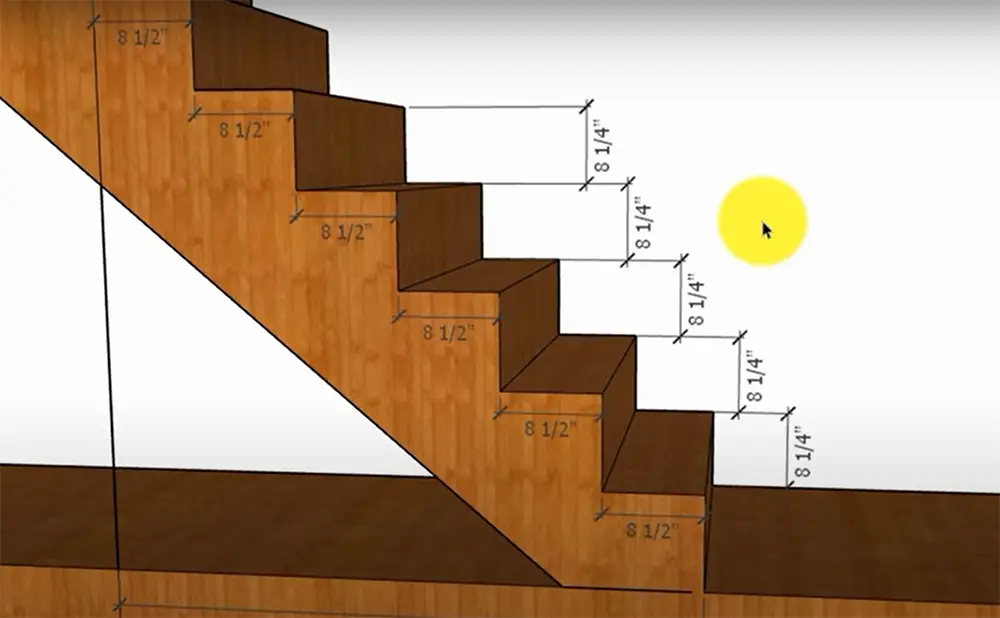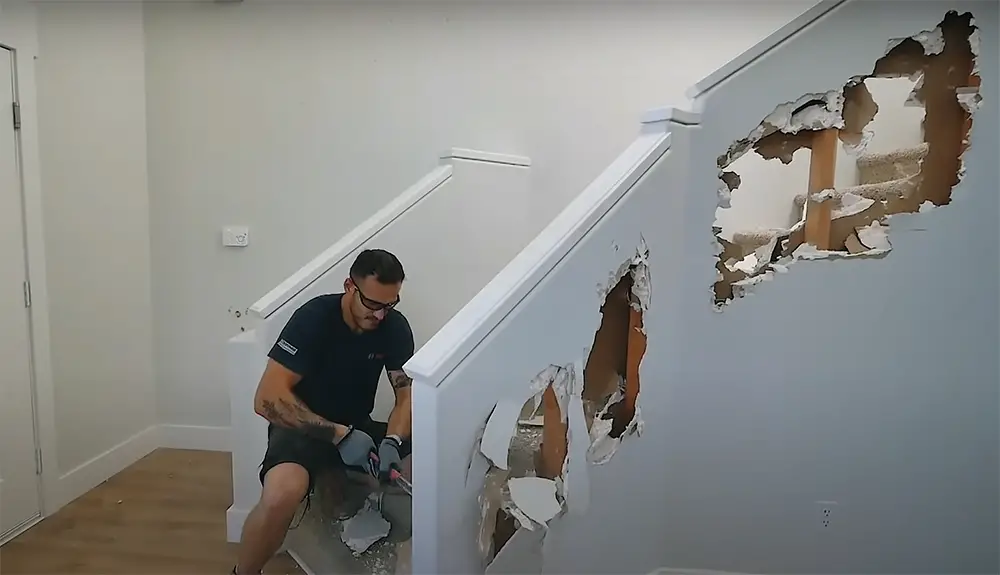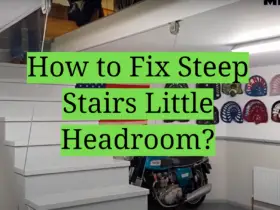If you’re like most people, you don’t enjoy climbing steep stairs with little headroom. In fact, it can be downright dangerous if you’re not careful! Thankfully, there are a few things that you can do to fix this problem and make your stairs safe and comfortable to climb again. In this article, we will describe the most popular methods to fix the issue and answer some common questions about doing it. We’ll also provide some useful tips on how to make the process easier and more efficient.
Indoor Staircase Standards
Before we get into the solutions, let’s take a quick look at some of the standards that apply to indoor staircases. According to the American National Standards Institute (ANSI), a “rise” is the height between two successive treads and a “run” is the horizontal distance from one thread to another. In general, your rise should be between six and eight inches and your run should be between ten and twelve inches. This will ensure a comfortable, safe climb.

If your stairs don’t meet these standards, they are considered steep. However, if your stairs are only slightly out of compliance, you may be able to adjust the height of the handrail or add a non-slip surface to the treads without making any major changes. [1], [2], [4]
What is Considered the Minimum Adequate Headroom Clearance?
The minimum adequate headroom clearance is defined by the International Residential Code (IRC) as being a vertical distance of no less than 80 inches (203 cm) from the tread nosing to any object above. This includes the height of handrails, which must be at least 36 inches (91 cm) high.
If your headroom is less than 80 inches, you will need to take corrective action before proceeding with any of the solutions described in this article. [1], [2], [4], [5]
Why Do You Need to Fix the Steep Staircase Problem?
There are a few reasons why you may want to fix the steep staircase problem in your home. Perhaps the most obvious reason is safety. A staircase with little headroom can be dangerous, especially if someone is carrying a heavy object or if there are children or elderly people using the stairs.
Another reason to fix this problem is comfort. Steep staircases with little headroom can be uncomfortable to climb, and they can also be a trip hazard. If you have guests in your home, you may not want them to have to deal with this issue. Finally, stairs with little headroom can simply be an eyesore. [1], [2], [3]
Can You Fix the Steep Staircase Little Headroom Problem without Making Major Changes?
If your stairs are only slightly out of compliance with the standards mentioned earlier, you may be able to adjust the height of the handrail or add a non-slip surface to the treads without making any major changes. This is often a more affordable option, and it can be a relatively easy process if you are handy and have some basic carpentry skills.

The Possible Costs of Fixing Steep Stairs
The cost of fixing steep stairs and little headroom will depend on the severity of the problem and the solution that you choose. If your stairs are only slightly out of compliance, you may be able to make the necessary changes yourself for a relatively low cost. However, if your stairs are significantly out of compliance or if you simply don’t feel comfortable making the changes yourself, you may need to hire a professional contractor to do the work for you.
There are a few things to bear in mind if you’re considering upgrading the little headroom in our steep stairwell.
Disassembling the old staircase by yourself is the cheapest option but can be a difficult and time-consuming task. The amount of materials required will also add up to the price.
Yes, you can do all the work by yourself and it will be cheaper, but if you’re not used to handling tools or carpentry, it would be best to consult with a professional. Hiring a contractor is the most expensive option but will give you the peace of mind that everything will be done correctly and safely. You can also expect a warranty on their work. [1], [2], [3]
What Should You Pay Attention to While Fixing the Stairs Headroom by Myself?
If you decide to fix the stairs headroom by yourself, there are a few things that you will need to pay attention to in order to ensure that the job is done correctly. First, you will need to make sure that you measure the height of your staircase carefully before making any cuts. Second, you will need to be careful not to cut the handrail too short. It is important to maintain a minimum height as required by code. Finally, you will need to make sure that the treads and risers are level and that there is no danger of slipping. A non-slip surface can help to prevent slips and accidents.
If you follow these tips, you should be able to fix the steep staircase little headroom problem in your home without too much difficulty. Remember, safety is always the most important consideration when dealing with stairs. If you have any doubts about your ability to safely make the necessary changes, it is always best to hire a professional contractor to do the work for you.

Now that you know what to expect, let’s overview the most common options to fix the little headroom problem of your indoor stairs.
The Best Methods to Fix Steep Stairs Headroom
There are a few different methods that you can use to fix the little headroom problem in your indoor stairs. Each of the solutions below has its own set of pros and cons, so it is important to understand the options before making a decision.
Dismantle and rebuild the stairs
This is not the best option if your goal is only to make the staircase safer. If your stairs are significantly out of compliance or if they are in poor condition, dismantling and rebuilding them may be the best solution. This option allows you to customize the staircase to meet your specific needs, and it will also ensure that it meets all safety standards. You can also make the stairs to meet the modern regulations by completely overhauling them.
It’s the most time consuming method and it can be expensive, but if you want a totally new staircase this is the way to go. Alternatively, there are companies that will take your old stairs and remake them with modern materials and to meet the new standards for a fraction of the cost of rebuilding.
If your goal is only to make the staircase less steep, then this option may be overkill. In most cases, it is possible to make the necessary changes without having to rebuild the entire staircase. [1], [2], [3]
Add more landing to the stairs
You may be able to reduce the little headroom problem by adding extra landing room if your steps are too steep.
This method is only available if your house design allows it as you will have to create a switchback steps design. This will reduce the steepness problem by a large margin. But you will also need to be careful not to make the stairs too narrow, as this will make them more difficult to use.

It is less time consuming than removing and reinstalling the entire staircase. However, it is still a major project that will require some planning and preparation. Unfortunately you will have to increase the thickness of the tread and this might not be possible in all cases. If you have a tight space or if the stairs are already quite thick, then this option may not be available to you.
Adding more landing to your stairs can be a good solution if you only need to make a small change to the steepness. However, if your stairs are significantly out of compliance, this method is not likely to be effective.
Another disadvantage of this method is that it can be expensive, as you may need to purchase or rent a specialist in order to complete the job. This is also a complicated and time-consuming process, so it should be done only by a professional if possible. [1], [2], [3]
Make the stairs deeper
You may also be able to fix the little headroom problem by making the stairs deeper. This is a relatively easy process, and it can be done without making any major changes to the structure of the stairs.
If you decide to add a new piece of wood, you will need to make sure that it is attached securely and that there is no danger of slipping. A non-slip surface can help to prevent slips and accidents from happening. [1], [2], [3], [6]
Add a handrail to your stairs
Adding a handrail to your stairs can also help to improve the safety. This is because a handrail will provide support and stability, which can make it easier to use the stairs.
A handrail can also help to prevent falls, as it will give you something to grip onto if you lose your balance.
Installing a handrail is a relatively simple process, and it can be done without making any major changes to the structure of the stairs.
However, you will need to make sure that the handrail is installed correctly and that it is strong enough to support your weight. A professional installer will be able to advise you on the best type of handrail for your needs. [3]
Comparison of Methods to Fix Steep Stairs with Little Headroom
Steep stairs with little headroom can be a safety hazard and an inconvenience. There are several methods to fix this issue, each with its own advantages and disadvantages. In this table, we compare various indicators of the most common methods to fix steep stairs with little headroom.
The table below compares four methods to fix steep stairs with little headroom: adding a landing, changing the pitch of the stairs, lowering the ceiling, and installing a spiral staircase. The indicators compared include the cost, the required space, the amount of time to complete the project, and the overall difficulty of the project.
| Method | Cost | Space Required | Time Required | Difficulty |
|---|---|---|---|---|
| Adding a landing | $1,500 – $5,000 | 4 ft x 4 ft | 2-3 days | Medium |
| Changing the pitch of the stairs | $1,500 – $5,000 | None | 2-3 days | Hard |
| Lowering the ceiling | $5,000 – $10,000 | Entire ceiling | 1-2 weeks | Hard |
| Installing a spiral staircase | $10,000 – $30,000 | 4 ft x 4 ft | 1-2 days | Easy |
Adding a landing is a cost-effective and relatively easy method to fix steep stairs with little headroom. However, it does require additional space, which may not be possible in all situations. Changing the pitch of the stairs can be a difficult project that may require significant alterations to the existing structure. Lowering the ceiling can be an effective solution, but it is also the most expensive and time-consuming method. Installing a spiral staircase is a relatively easy solution that requires minimal space, but it can be expensive.
Overall, the choice of method will depend on the specific situation, including the available space, the budget, and the desired outcome. It is recommended to consult with a professional before starting any project to ensure that the chosen method is safe and appropriate for the specific circumstances.
Check more articles to improve your bedroom:
- Where to Install Smoke Detector In a Bedroom With a Ceiling Fan?
- How to Hide the Laundry Basket in a Bedroom?
- How to Mix and Match Bedroom Furniture?
FAQ
How can you fix stairs that are too steep?
There are a few different methods that can be used to fix stairs that are too steep. The most common methods include removing a staircase with installing a new one, adding more landing space, making the stairs deeper, and adding a handrail.
If your stairs are significantly out of compliance, you may need to take more drastic measures in order to make them safe and usable. And if you want only minor adjustments to make your staircase safer, simpler options will do just fine.
What is the minimum headroom clearance needed on a staircase?
The minimum headroom clearance needed on a staircase depends on the height of the stairs and the width of the staircase. There must be at least 80 inches of headroom clearance, measured vertically from a line connecting the bottom of the nosings, according to the IBC stair headroom clearance requirements.
Is stairs modification a costly investment?
The cost of modifying your stairs will vary depending on the method that you choose to use. Hiring a carpenter to completely rebuild your stairs is likely to be the most expensive option, while adding a handrail or making the stairs deeper are more affordable solutions. However, it is important to remember that any modifications should be carried out by a professional for safety reasons.
Useful Video: Longer Stair Treads Can Create Headroom Problems – Stairway Modification Tips
Conclusions
In conclusion, there are a few different methods that can be used to fix stairs that are too steep. The most common methods include removing a staircase with installing a new one, adding more landing space, making the stairs deeper, and adding a handrail.
Remodeling your steep staircase with a little headroom is needed for safety reasons, but the costs can be a big deciding factor. Be sure to consider all your options and choose the one that is best for you and your budget.
We hope this article has been helpful in answering some of your questions about how to fix steep stairs with little headroom and make your home safer.
References:
- https://www.thehomehacksdiy.com/how-to-fix-steep-stairs-little-headroom-4-great-ways/
- https://bulbtoblossom.com/how-to-fix-steep-stairs-little-headroom/
- https://laokoonhome.com/how-to-fix-steep-stairs-little-headroom/
- https://www.doityourself.com/stry/standard-stair-dimensions-for-indoors
- https://blog.lapeyrestair.com/stair-head-clearance
- https://blog.lapeyrestair.com/stair-riser-height-tread-depth










When I had to fix the steep stairs leading to my basement, I did some research and learned there are a few options to make them less steep. I ended up remodeling the stairs completely to reduce the incline. It was a big project but worth it for safety. I had a contractor come in to redo the framing and install new stair treads at a lower angle. It made a huge difference and now the stairs are much easier to navigate.
After moving into our old home, the original wooden stairs down to the basement were terribly steep and narrow. I was worried someone would get hurt on them. We had a contractor rebuild the stairs with a more gradual slope and wider steps. It wasn’t cheap, but after the renovation the basement stairs are much safer for my family to use.
When we bought our last house, the stairs descending from the kitchen into the basement were dangerously steep. I was determined to fix them. I had a carpenter completely redo the stairs, moving the opening below to allow for a less steep staircase. It was a big undertaking but the end result is much better. The new stairs are easier to navigate with groceries and laundry baskets.
The steep, rickety stairs to our basement used to make me nervous. I was always worried one of my kids would fall. We couldn’t afford a full renovation, so I had a contractor just replace the treads with thicker, sturdier wood planks. Widening the steps made a difference. Now the steepness doesn’t seem as precarious.
After I fell down my basement stairs and sprained my ankle, I knew I had to do something to fix them. They were way too steep. I had a contractor come in and reframe the staircase, moving it over a few feet to change the incline. Now I can walk up and down safely. It was a worthwhile investment.
When we moved into our home, the original stairs from the kitchen to the basement were incredibly steep. I was nervous my elderly mom would slip and fall. We had a carpenter reframing the staircase with a landing halfway down to break up the slope. The landing also created a nice spot to rest my laundry basket on the way up!
Soon after buying my house, I realized the stairs to the basement were dangerously steep and narrow. I hired a contractor to rebuild them with a wider staircase and more gradual slope. It was pricey but improved the safety and function tremendously. No more tripping down into the basement for me!
The steepness of the stairs from our main level down to the basement made me cringe. I was constantly worried about falls. We had a contractor redo the entire staircase, moving the basement entrance to allow for a gentler slope. The project was costly but I’m relieved the stairs are now safe for my family.
When we moved in, the old wooden stairs to the basement terrified me. The incline was far steeper than code allowed. I brought in a contractor to rebuild them, adding a landing midway to reduce the slope. It was a big job but I’m much happier navigating those basement stairs now.
Soon after purchasing my old home, I realized the stairs descending to the basement were dangerously steep. I had a carpenter completely redo them with a more gradual slope and wider treads. It wasn’t cheap but the peace of mind and improved safety are worth every penny.
The original stairs from my main floor to the basement were very steep – almost like a ladder! I was nervous someone would fall. A contractor reframed the staircase with a gentler slope and landings at the halfway point. Though expensive, the project was worthwhile for safety. I can now carry laundry without fear!
When we bought our century home, the stairs to the basement were incredibly narrow and steep – definitely not up to code. I hired a contractor to redo them completely with a more gradual slope and wider steps. It was a big investment but I’m glad we can now safely access our basement.